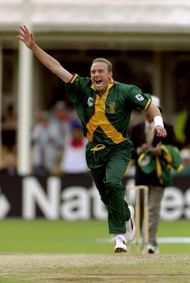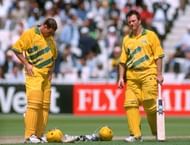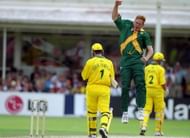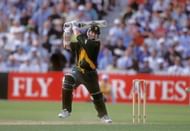If you had one chance to show the beauty of cricket to someone and had to make them watch a single match, which captured all the aspects related to the sport, which match would you choose? Last year after a public voting, ICC announced the greatest ODI match of all time: the 438-434 run marathon came out trumps.
But what Johannesburg witnessed in 2006, was a grossly inflated display of only a single skill in cricket, batting. Taking nothing away from the sheer audacity of the numbers in that match, a newbie would have mistaken cricket to be a blown up version of baseball, where ‘home runs’ were scored freely and bowlers (pitchers) simply went through the routine of turning their arm over, forgetting to keep their foot behind the line quite carelessly.
The best quality on display in the match was of pressure being absorbed by the South Africans. The ‘chokers’ defied that tag by giving an astonishing display of batting under pressure. The Proteas deserve all the credit for showing the world that ‘miracles’ were possible. That game changed the way future teams would approach a target. It redefined Limited Overs cricket. But frankly, it wasn’t cricket at its best.
That instance, when the best of everything that cricket signifies was on display, occurred on 17th June 1999 in Birmingham.
If 2006 Johannesburg was how Peter Jackson would have envisioned the game of cricket, then 1999 World Cup semifinal was a quintessential Christopher Nolan masterpiece. On a big stage, elite performers promised wonders. The story was full of twists and turns and the audience was glued to the seat till the last moment. And the ending, oh the ending! It left everyone gasping for breath and the discussions continue to this day as to what really transpired in the middle of that 22 yard pitch, on what turned out to be the final delivery of the match.
There was great batting, mesmerizing spin, breathtaking swing and athletic fielding with cricket, before Ravi Shastri had ruined the term, being the ultimate winner.
Prologue
Australia and South Africa had finished on same points in the Super Six stage, along with Pakistan who topped the group. Australia finished ahead of the Proteas with a mere lead of 0.184 in Net Run Rate. Another telling fact was that the Super Six encounter between the two had seen Herschelle Gibbs drop an easy catch of Steve Waugh, who then took Australia out of the sticky situation they found themselves in and played a match-winning knock. ‘What if’ was to find a new meaning in cricketing folklore due to these very facts on the day of the semifinal.
South Africa won the toss and elected to field first. Steve Waugh wasn’t perturbed a bit as he admitted to preferring to bat first had the coin flipped their way. After a not-so-impressive outing in the previous matches, Shaun Pollock finally found his bearings and dismissed the dangerous Mark Waugh for a duck. Donald and Kallis joined in and pushed Australia to 68/4 after 17 overs, with Donald getting Ponting and Lehmann in a single over. Aussies had lost Gilchrist, Mark Waugh, Ponting and Lehmann. With their skipper and greatest finisher left to come, they had only one chance at making something out of this match and South Africa smelled blood.
Advantage – South Africa.
Act 2
The biggest appeal of a One Day International, displayed more so starkly after the advent of T20s, is the rebuilding phase in an innings. Presented with a potential shipwreck situation, a cricketer finds within himself the ability to absorb the pressure and gather the fallen woodwork. It’s a condensed form of Test cricket, but with the luxury of seemingly unlimited time taken away from the batsmen. Steve Waugh had done the job earlier against the same opposition and with the master of repairing shipwrecks present at the other end of the pitch, he did not let down his team.
Waugh and Bevan put together a 90 run partnership in a little over 22 overs. South Africa had found more than an opening earlier in the match, but the failure to break this partnership was one of the many ‘what if’ moments which could have made them World Champions. At 158/4 in 39.2 overs, Australia wasn’t far away from posting a challenging score on that pitch.
Advantage – Australia.
Act 3
With South Africa slowly losing their cool in the middle, Shaun Pollock’s 8th over (40th of the innings) removed both Waugh and the next batsman, Tom Moody, bringing out some sighs of relief from the Proteas. Bevan and Warne put up a 40 run partnership which ended when Warne’s nervy stay in the middle was finally cut short by Pollock who had displayed both brilliance and mediocrity with down the leg bowling on occasions.
With Donald striking another double whammy in the next over and Pollock getting his 5th wicket, Australia’s late collapse ended their total on a seemingly mediocre total of just 213. At 68/4, South Africa would have hoped to have gotten them out a bit cheaper, while from 158/4, Australia would have been disappointed at the final score.
Advantage – South Africa.
Act 4
Chasing a seemingly easy total, South Africa got off to a good start. McGrath and Reiffel were not able to get much out of the pitch and Gibbs was in a form where he dispatched almost anything full to the boundary. Soon, the duo of Gibbs and Kirsten had put together 48 runs in 12 overs without any hiccup.
Advantage – South Africa.
Act 5
 But what made Australia so dangerous, was the fact that even after nullifying the opening burst of McGrath and Reiffel, there was a chubby blonde waiting to unleash some wizardry. You knew, you almost knew that even though South Africa had countered the quicks, Shane Warne would do something or the other to change the order of things.
But what made Australia so dangerous, was the fact that even after nullifying the opening burst of McGrath and Reiffel, there was a chubby blonde waiting to unleash some wizardry. You knew, you almost knew that even though South Africa had countered the quicks, Shane Warne would do something or the other to change the order of things.
His first over was negotiated well. On the 2nd ball of his 2nd over, Shane Warne did what he does best. He spun the ball, and spun it big. As the ball left Warne’s hand, Gibbs got his front foot out, ready to drive it. But halfway through, he realised that it wasn’t as full as he’d wanted it to be. Trying to force the foot back, he tried to flick it to the on side. But he was already done in by the master leggie; pitching outside the leg stump, the ball spun all the way to kiss the top of off-stump, leaving Herschelle Gibbs completely out of balance and with a shocked look on his face. 6 years after ‘that ball’, Gibbs knew how Gatting felt at Old Trafford.
2 overs and 5 runs later, Gary Kirsten was facing Warne. As Warne pitched it outside off, Kirsten decided to slog him out of the park in what turned out to be very poor judgement. The ball spun, missed the almighty heave and crashed onto the stumps.
A ball later, Cronje tried to drive a full delivery outside leg stump to the on-side. Of course, the ball spun, caught the edge and off went the skipper. Barely 6 overs later, Cullinan was run-out by a direct throw from Bevan.
Just when South Africa had thought that they had got a decent start, Shane Warne’s triple blow brought them back to the reality of the challenge. It was not going to be a ride in the park. The game was on. South Africa 62/4 after 22 overs.
Advantage – Australia.
Act 6
South Africa’s innings spanned out on quite the same lines as Australia’s. After a flurry of wickets at the top, the repair job was done by Jacques Kallis and Jonty Rhodes, the duo putting up 84 in 19 overs. With the required run rate reaching 7 and match into its last 10 overs, Rhodes pulled one straight to deep square leg. At 145/5, with South Africa needing 69 runs off 57 balls, it was anyone’s game.
Act 7
Kallis and Pollock’s 30 run partnership off 26 balls took South Africa closer to the target but the duo’s dismissal in consecutive overs tilted things in favour of Australia. Klusener held one end as South Africa lost Boucher and Elworthy in quick succession.
At 198/9, South Africa needed 16 runs off 8 balls. Australia needed one wicket. In a World Cup semifinal way back in 1999, it was a monumental ask for the Proteas.
Advantage – Australia.
Act 8
Klusener slogged the next ball towards long on and the fielder, Paul Reiffel, failed to get underneath it properly and instead, parried it over the rope for a six. It was a memorable moment in the match when just after the ball crosses over the rope, David Shephard was shown watching towards the boundary, mouth agape. Unbelievable things were happening in the middle, and Shephard could’ve been forgiven for baring his disbelief. Klusener took a single off the next ball and retained the strike.
9 needed off 6 balls, 1 wicket in hand.
BAM! BAM!
Klusener cleared his front leg and smashed the first two deliveries through the off side for consecutive boundaries. That he murdered them, would have been an understatement. South Africa now believed, the crowd went berserk, the Australians looked stunned. Lance Klusener was doing the impossible.
And the nerves went crazy the next ball. Klusener went for a mighty slog on the leg side, didn’t connect and the ball went as far as mid on. Having called all his fielders inside the circle, Waugh gave his side the best chance to qualify for the final in that moment. Lehmann collected the ball and his underarm throw missed the non-striker’s stumps by a whisker. Donald, having trudged off the crease at the moment of the delivery, would have found himself quite short had Lehmann found the target.
The Australians had their heads buried in their hands. Donald was smiling, not believing what he had almost done. Klusener didn’t give his emotions away.
1 needed off 3 balls, 1 wicket in hand.
The next instance is perhaps the most watched ending in the history of the game.
Klusener hit the ball, but couldn’t time it properly as it only went as far as the mid-off, bisecting the bowler and non-striker. But he ran with all his might. Without calling, without looking, he ran. Donald, at the other end, watched the ball, watched it go towards the fielder. He didn’t look at Klusener dashing towards him and perhaps still shaken by the near miss on the previous ball, didn’t commit himself for the single.
Only when Mark Waugh had passed the ball to Fleming, did he see Klusener by his side at the non-striker’s end. He ran towards the other end then, letting the bat fall down from his hands. But Fleming coolly sent down the 2nd most famous underhand throw from an Australian towards Gilchrist who disturbed the stumps and the party for South Africa.
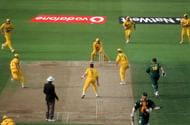
Fleming coolly sent down the 2nd most famous underhand throw from an Australian towards Gilchrist who disturbed the stumps and the party for South Africa.
Left halfway down the pitch, alone, Donald took off his helmet and with bowed head, turned back to lift his fallen bat. Klusener didn’t stop running, almost knowing the outcome without looking back. But he just turned his head once and continued walking. Australians celebrated in the middle, the Aussie fans rejoiced wildly in the stands. The minute difference of 0.184 had made Australia qualify for the finals despite the match being tied.
Epilogue
It was the first tie in the history of World Cup (incidentally, all subsequent World Cup have had a tied match) and definitely the most exciting one.
If South Africa thought 1992 semifinal was a heartbreak, they fell short of words to describe this feeling after 1999. Australia routed Pakistan in the final and lifted their 2nd World Cup. It kick-started the era of dominance for the 2nd superpower in cricket. Australia won 2 more World Cups after that and became the best team in the world. South Africa remained a side filled with champions but ultimately, ‘chokers’.
But what if Donald had seen Klusener running? What if Klusener had made a clear call to Donald?
Well, it would have still remained the greatest cricket match in the history of ODI cricket.
You can read the rest of the series here.
Looking for fast live cricket scores? Download CricRocket and get fast score updates, top-notch commentary in-depth match stats & much more! 🚀☄️

